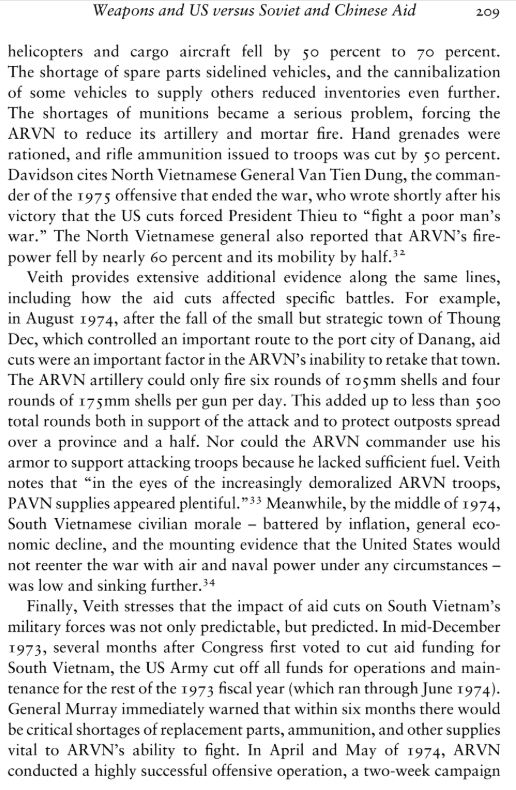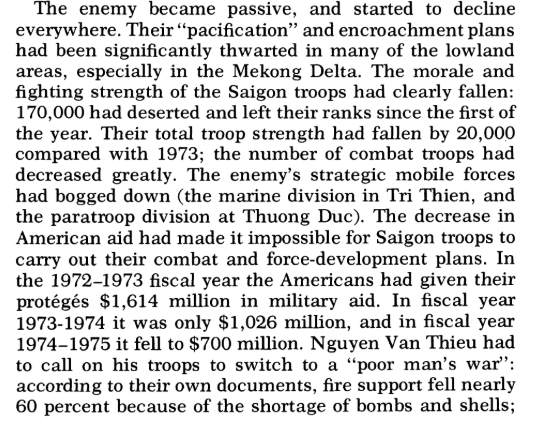It says that Davidson and Veith claim the problem was supply stocks but does not state the South Vietnamese, Americans, or North Vietnamese governments all agree it was the cuts. Additionally, their non-anecdotal analysis is entirely based on the conditions among "the teeth" that, as I already noted, can just as well be attributed to problems in organization and distribution among "the tail" as it could to any lack of "tail" to begin with. On the other hand, the
VPA's official history notes how unexpectedly vital captured ARVN supplies were to the conduct of the offensive, with the 17,000 rounds of artillery ammunition captured in the relatively small Central Highlands depots equaling the amount of ammunition the PAVN had originally planned to expend in the entire 1975 campaign! The subsequent fall of Hue, which saw another 100 tons of ammo captured (about another 10,500 rounds in 105mm ammunition). Your cited source doesn't even exactly repudiate the idea that the ARVN overall fought poorly in 1975, merely noting it fought well in the campaigns of 1972 (which is true, but it also tellingly ignores why that was and what was actually different between the three years). Now, if one wants to actually examine the effects the system of leadership had on the ARVN as opposed to the severance of American aid, then one has to look no further then the contrast between the 1975 performance of the 1st ARVN division and the 18th.
The 1st Division had a reputation of being the best in the ARVN and so was a choice posting for the sons of the rich and powerful. By 1975, it’s formerly skilled officers had either died in earlier operations or been sidelined by political factors and replaced largely with pampered wannabe-generals. It was on the defensive perimeter around Hue when the Communists attacked. Though facing only a regiment, the division commander panicked after only 48 hours of fighting and surrendered his entire division, opening a huge gap in the ARVN lines, leading to the surrender of two other divisions and the rapid collapse of the entire defense of Hue. The Communists were so impressed with the readiness of the division to surrender that after only a brief 1 week "re-education" they put the 1st Division back to work moving supplies for their advancing Corps.
By contrast, the 18th Division had a reputation as the absolute worst in the ARVN. It had formerly been the 10th, but was renamed as "Number 10" was Vietnamese slang for "the worst." The division had recently been assigned to the command of General Le Minh Dao. Dao was one of the best commanders in the ARVN, so good that the government identified him as a potential threat and promptly shuffled him off to the sort of dead end career post the 18th was supposed to be in response. Dao whipped the 18th into shape, replacing the incompetent subordinate officers, retraining the division and rebuilding morale. The 18th was well to the rear and took no part in the early battles around the Central Highlands, Hue and Da Nang... all disasters that saw the bulk of Vietnam's million-man army evaporate. By the time the Communists were advancing on Xuan Loc where the 18th had drawn up its lines there was little left to block the road to Saigon.
To date in the campaign other ARVN units had regularly folded in hours or days to smaller VPA forces, surprising even the Communists who had expected a stiffer fight. At Xuan Loc the 5,000 men of the 18th faced an entire Corps of over 40,000. The Communists attacked, expecting an easy victory but were repulsed. They brought up more troops and attacked again, penetrating into the town before a series of ferocious counter-attacks again drove them out. They then pounded the town with heavy artillery and tried again in a masssive assault of tanks and infantry. After house to house and street by street fighting in which the infantry of the 18th knocked out dozens of T-54 tanks the VPA was again thrown back. When the 18th had been expected to maybe by a few days, it had now held for over a week.
The ARVN dared to hope that they might actually win, and plans were made to reinforce the 18th with the 1st Airborne Brigade, another of the South's elite formations. A massive helicopter drop was planned near Xuan Loc. Tragically the Ops Officer for the 1st Airborne sold the entire plan to the Communists, and the 1st Brigade dropped into one of the largest ambushes in history and was quickly annihilated.
With other ARVN units to the west breaking, half its riflemen casualties, almost out of ammunition, cut off and encircled with no chance of any reinforcement, the 18th's position had become hopeless. The VPA drew up six divisions around Xuan Loc and offered the 18th a chance to surrender. General Dao stalled through the day, and then in the night lead his two remaining regiments in a daring breakout to the south, punching through the Communist lines and escaping with his surviving troops to Saigon.
Dao and his men had held for an incredible two weeks in a stand that would be legendary in any army. In the ARVN it was a legend tinged with tragedy: the battle had come too late, and the South Vietnamese government had not been able to do anything productive with the time won... the 11th hour had already passed. Saigon was still undefended and the ARVN proved unable to rally despite the momentary rush of hope. A week after the fall of Xuan Loc, Saigon surrendered and the war was over.
Had the bulk of the ARVN in 1975 enjoyed the sort of leadership by men even men half as good as Dao, the VPA offensive would have been handily crushed regardless of the state of American aid. Instead, leader’s like Dao were shunned and shunted into dead-end career posts where they couldn’t fundamentally alter the strategic situation while fops like those who commanded the 1st were promoted. Given such a command culture and given that the bulk of ARVN enlisted on average did not believe the South Vietnamese government to be a legitimate one, it’s unsurprising that the 1st division was the rule, the 18th the exception, and it’s hard to see why just giving the Vietnamese more stocks would suddenly change that.
This is a misleading comparison, because attempting to compare value by what other armies have is a nonstarter for understanding how important China was a source to the VPA. Cite what the VPA received in that time frames from other sources, such as the USSR or domestic production, as well existing stocks are.
Well, for what the Soviets sent,
I can only find the monetary figures at the moment: 1.395 billion (in 1975 dollars) in military aid and another 1.765 billion in economic aid. As for what the Vietnamese existing stocks in 1975 were... well, the VPA’s official history places the total stock of shells army wide in 1975 at 100,000. That is all types, for both towed and vehicle-mounted guns. A little under 1/5th were initially allocated to the 1975 offensive, with the capture of munitions from South Vietnam making up the rest.
It's not because it took four years for said operation to finally be carried, and ignores that Cambodia lacked anything close to what the ARVN was; same goes for the border battles between China and Vietnam concurrent to the Cambodian invasion.
That the operation was carried out in 1979 is not proof that it could not have been carried out earlier: there are any number of reasons why the VPA might not have carried out the operation sooner (not least because their relations with the Khmer Rouge in 1975 were actually pretty good, at least compared to how they would be later, and it took awhile for relations to sour enough to the point that invasion was deemed a prudent measure) and that Cambodia couldn't put up the same sort of resistance the ARVN might have been able too doesn't change that the VPA was rolling in with forces roughly equivalent to what it had rolled in with back in 1975, which suggests the ability to move and sustain such forces in combat.
Also, in looking for the Soviet figure of aid provided, I found that Chinese aid didn't terminate until 1978, which makes the entire discussion something of a moot point.

